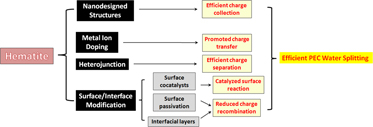Crossref Citations
This article has been cited by the following publications. This list is generated based on data provided by
Crossref.
Toroker, Maytal Caspary
2014.
Theoretical Insights into the Mechanism of Water Oxidation on Nonstoichiometric and Titanium-Doped Fe2O3(0001).
The Journal of Physical Chemistry C,
Vol. 118,
Issue. 40,
p.
23162.
Shen, Shaohua
Zhou, Jigang
Dong, Chung-Li
Hu, Yongfeng
Tseng, Eric Nestor
Guo, Penghui
Guo, Liejin
and
Mao, Samuel S.
2014.
Surface Engineered Doping of Hematite Nanorod Arrays for Improved Photoelectrochemical Water Splitting.
Scientific Reports,
Vol. 4,
Issue. 1,
Guo, Youhong
Fu, Yanming
Liu, Ya
and
Shen, Shaohua
2014.
Photoelectrochemical activity of ZnFe2O4modified α-Fe2O3nanorod array films.
RSC Advances,
Vol. 4,
Issue. 70,
p.
36967.
Zhang, Chuangli
Wu, Quanping
Ke, Xuebin
Wang, Juan
Jin, Xin
and
Xue, Song
2014.
Ultrathin hematite films deposited layer-by-layer on a TiO 2 underlayer for efficient water splitting under visible light.
International Journal of Hydrogen Energy,
Vol. 39,
Issue. 27,
p.
14604.
Wu, Quanping
Zhao, Jun
Liu, Kan
Wang, Hongyan
Sun, Zhe
Li, Ping
and
Xue, Song
2015.
Ultrathin hematite film for photoelectrochemical water splitting enhanced with reducing graphene oxide.
International Journal of Hydrogen Energy,
Vol. 40,
Issue. 21,
p.
6763.
Galán‐Mascarós, José Ramón
2015.
Water Oxidation at Electrodes Modified with Earth‐Abundant Transition‐Metal Catalysts.
ChemElectroChem,
Vol. 2,
Issue. 1,
p.
37.
Wang, Meng
Pyeon, Myeongwhun
Gönüllü, Yakup
Kaouk, Ali
Shen, Shaohua
Guo, Liejin
and
Mathur, Sanjay
2015.
Constructing Fe2O3/TiO2 core–shell photoelectrodes for efficient photoelectrochemical water splitting.
Nanoscale,
Vol. 7,
Issue. 22,
p.
10094.
Warwick, M. E. A.
Barreca, D.
Bontempi, E.
Carraro, G.
Gasparotto, A.
Maccato, C.
Kaunisto, K.
Ruoko, T.-P.
Lemmetyinen, H.
Sada, C.
Gönüllü, Y.
and
Mathur, S.
2015.
Pt-functionalized Fe2O3photoanodes for solar water splitting: the role of hematite nano-organization and the platinum redox state.
Physical Chemistry Chemical Physics,
Vol. 17,
Issue. 19,
p.
12899.
Shen, Shaohua
Chen, Jianan
Cai, Li
Ren, Feng
and
Guo, Liejin
2015.
A strategy of engineering impurity distribution in metal oxide nanostructures for photoelectrochemical water splitting.
Journal of Materiomics,
Vol. 1,
Issue. 2,
p.
134.
Monllor-Satoca, Damián
Bärtsch, Mario
Fàbrega, Cristian
Genç, Aziz
Reinhard, Sandra
Andreu, Teresa
Arbiol, Jordi
Niederberger, Markus
and
Morante, Joan Ramon
2015.
What do you do, titanium? Insight into the role of titanium oxide as a water oxidation promoter in hematite-based photoanodes.
Energy & Environmental Science,
Vol. 8,
Issue. 11,
p.
3242.
Zheng, Jin You
Son, Se In
Van, Thanh Khue
and
Kang, Young Soo
2015.
Preparation of α-Fe2O3 films by electrodeposition and photodeposition of Co–Pi on them to enhance their photoelectrochemical properties.
RSC Advances,
Vol. 5,
Issue. 46,
p.
36307.
Lee, Chulho
Lee, Dongeun
Kim, Sunkyu
Yoo, Hyeonseok
and
Choi, Jinsub
2015.
Photoelectrochemical Performance of Hematite Nanoparticles Synthesized by a DC Thermal Plasma Process.
Applied Chemistry for Engineering,
Vol. 26,
Issue. 3,
p.
306.
Hong, Tiantian
Liu, Zhifeng
Yan, Weiguo
Wang, Bo
Zhang, Xueqi
Liu, Junqi
Wang, Junkai
and
Han, Jianhua
2015.
A novel quaternary solid solution photo-absorber material for photoelectrochemical hydrogen generation.
Chemical Communications,
Vol. 51,
Issue. 71,
p.
13678.
Mariño-Otero, T.
Oliver-Tolentino, M.A.
Aguilar-Frutis, M.A.
Contreras-Martínez, G.
Pérez-Cappe, E.
and
Reguera, E.
2015.
Effect of thickness in hematite films produced by spray pyrolysis towards water photo-oxidation in neutral media.
International Journal of Hydrogen Energy,
Vol. 40,
Issue. 17,
p.
5831.
Warwick, Michael E. A.
Kaunisto, Kimmo
Carraro, Giorgio
Gasparotto, Alberto
Maccato, Chiara
and
Barreca, Davide
2015.
A study of Pt/α-Fe2O3 Nanocomposites by XPS.
Surface Science Spectra,
Vol. 22,
Issue. 1,
p.
47.
Bhandary, Nimai
Singh, Aadesh P.
Ingole, Pravin P.
and
Basu, Suddhasatwa
2016.
Enhanced photoelectrochemical performance of electrodeposited hematite films decorated with nanostructured NiMnOx.
RSC Advances,
Vol. 6,
Issue. 42,
p.
35239.
Yilmaz, Ceren
and
Unal, Ugur
2016.
Morphology and crystal structure control of α-Fe2O3 films by hydrothermal-electrochemical deposition in the presence of Ce3+ and/or acetate, F− ions.
RSC Advances,
Vol. 6,
Issue. 10,
p.
8517.
do Amaral Carminati, Saulo
Souza, Flavio L.
and
Nogueira, Ana F.
2016.
Enhancing Hematite Photoanode Activity for Water Oxidation by Incorporation of Reduced Graphene Oxide.
ChemPhysChem,
Vol. 17,
Issue. 1,
p.
170.
Chen, Xiangyan
Wang, Meng
Chen, Jie
and
Shen, Shaohua
2016.
Electrophoretic deposition of nanostructured hematite photoanodes for solar hydrogen generation.
Journal of Materials Research,
Vol. 31,
Issue. 11,
p.
1547.
Fu, Yanming
Dong, Chung-Li
Zhou, Zhaohui
Lee, Wan-Yi
Chen, Jie
Guo, Penghui
Zhao, Liang
and
Shen, Shaohua
2016.
Solution growth of Ta-doped hematite nanorods for efficient photoelectrochemical water splitting: a tradeoff between electronic structure and nanostructure evolution.
Physical Chemistry Chemical Physics,
Vol. 18,
Issue. 5,
p.
3846.
